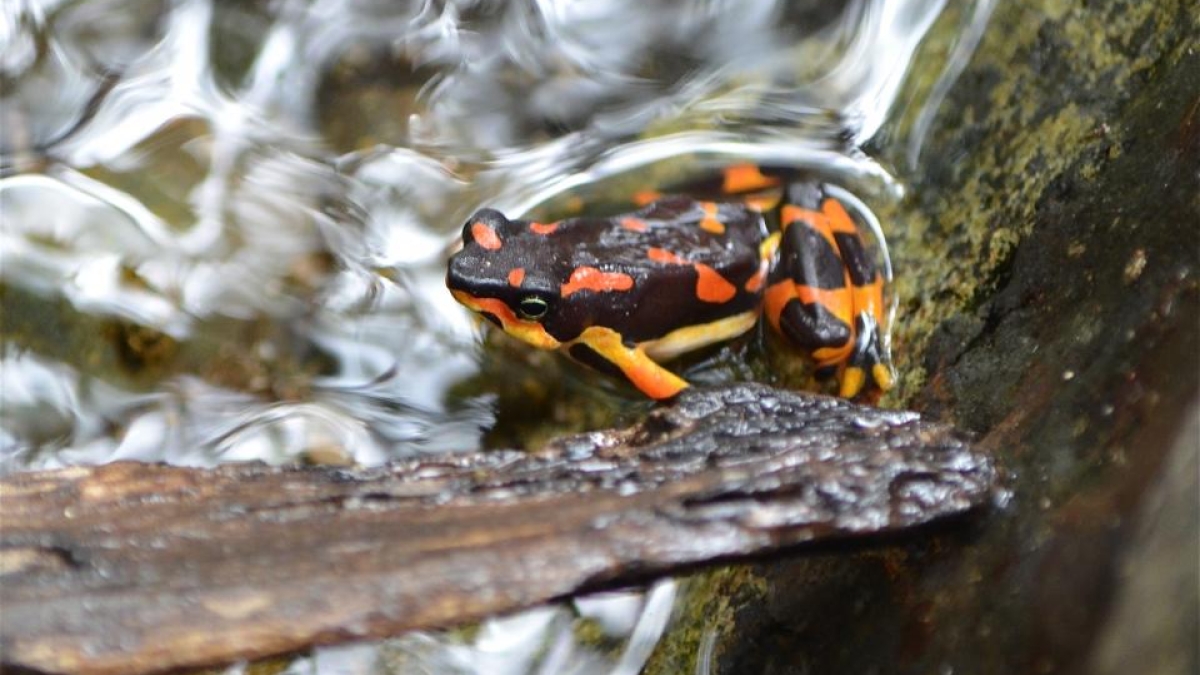Help save a species: Harlequin frog
ASU School of Life Sciences' campaign aims to revive animal thought extinct until recently

Stories about species becoming extinct are all too common in the news.
This isn’t one of those stories.
What’s different this time is that this species, a gorgeous frog living in Costa Rica, has a chance to be saved.
Now.
With your help.
A tiny population of harlequin frogs (pictured above) was recently rediscovered along a riverbank in Costa Rica when a local kid walked into a biology field station with one in his hand. The researcher on duty immediately recognized what the boy held.
“Not only was it not supposed to be there, it was supposed to be gone,” said Jan Schipper.
Schipper, a conservation and wildlife biologist in the School of Life SciencesThe School of Life Sciences is an academic unit of the ASU College of Liberal Arts and Sciences. at Arizona State University, is leading the campaign to save the frogs, which are estimated to number in the hundreds.
The harlequin frogs were thought to have gone extinct after populations were wiped out by a fungal disorder. Young frogs aren’t living to the age they can reproduce.
“The population is aging out of reproduction,” Schipper said. “If there is no reproduction, there is no frogs.”
There is time to save them.
But not much time.
This is an extremely rare opportunity. Usually we hear that something is extinct when it’s extinct, and by then it’s too late, Schipper said.
“It’s not too often we know of a population with numbers of less than 1,000 individuals,” he said. “They’re well below 1,000 for this one. ... The real challenge is actually doing something about the situation.”
The frogs begin their breeding season in October and November.
“If next year comes around and we don’t have any breeding, then the clock stops ticking and time is up,” Schipper said.
Schipper and his colleagues are looking for small funds to start a biosecurity protocol on site. What that means is essentially quarantining the area against outside contamination. The frogs live on a ranch, and the ranch manager supports conservation. If all vehicles entering the ranch and all people who visit the frog’s habitat are decontaminated, the frog stands a good fighting chance of surviving.
“We really need to step up this project,” Schipper said. “We need to improve the research, we need to increase the testing that we’re doing for (the fungus) on the ground, and finish the surveys of the population on the ground this season, or it may the last chance we have.”
The Phoenix Zoo has donated $5,000 in seed money.
“The urgency around this particular ask is around the breeding season,” Schipper said. “We need more than $5,000 to save this species, but this is a small step in that direction.”
To learn more, visit Pitchfunder.com.
Top photo by Sandra Leander/ASU
More Science and technology

ASU planetary scientist to be inducted into the National Academy of Sciences
The National Academy of Sciences is inducting School of Earth and Space Exploration Director Meenakshi Wadhwa into the 2023 class of new members for her pioneering work in planetary sciences and…

Unlocking the potential of AI for homeland security
“Can we do what we're doing now cheaper, more efficiently, more effectively?” Adam Cox, director in the Office of Strategy and Policy at the Department of Homeland Security Science and Technology…

SpaceHACK highlights student solutions to environmental challenges, digital divide
By Adrianna Nine About 250 students from around the world convened online and at Arizona State University on March 22 for the ASU Interplanetary Initiative’s second annual SpaceHACK for…